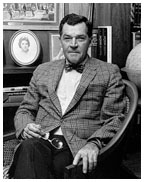
|
November 8, 2006: From the Editor
President Robert Goheen ’40 *48 in his office, circa 1976. (photograph by John W. H. Simpson ’66, Princeton Alumni Weekly Photograph Collection, Princeton University Archives) |
Seventy years ago this fall, Robert Goheen ’40 *48 arrived on the campus as a freshman, beginning an extraordinary association with Princeton as student, alumnus, junior professor, and president. Few have had a larger role in shaping the Princeton of today. The University recently celebrated Goheen’s anniversary with a reception and exhibition highlighting his seven decades on campus; beginning on page 22, PAW contributor Merrell Noden ’78 explores Goheen’s contributions and some of the ideas behind them.
Last year, Goheen sat for four hours with University archivist Daniel Linke to prepare an oral history of his tenure. He spoke about his 1957 appointment, at 37, as the youngest Princeton president since before the Revolutionary War, about coeducation, and about how difficult it was to recruit talented black students to Princeton because of the University’s poor record in racial issues — including the omnipresent legacy of Woodrow Wilson 1879, who, Goheen learned, had defended segregation in the civil service. “That was a shocker,” Goheen told Linke, “because to me, he had always been a hero.”
Though he didn’t think it at the time, the first 10 years of Goheen’s presidency were “a wonderfully calm time on campus,” he recalled. That changed abruptly. The small exhibition in Firestone Library, which will run through December, illustrates the times. On display are a copy of the 300-plus-page report submitted in 1968 on “The Education of Women at Princeton,” a 1969 newsletter announcing the “Princeton Vietnam Assembly,” and a photo of Goheen sitting on a stage and glaring at students who were heckling Secretary of Interior Walter Hickel in 1970.
That photo clearly illustrates what Goheen thought of those who would refuse to allow a person to speak. Other items in the exhibition show what critics thought of Goheen. A 1969 flier for the Alumni Council to Involve Ourselves Now, or ACTION, listed seven major complaints, ranging from the nonenforcement of parietals to an admission policy that “discriminates against applicants of backgrounds similar [to] those attending Princeton in the past.” ACTION also blamed Goheen for an increasing number of “hard-to-handle faculty,” and the fact that “already about 10 percent of the 170 new girl recruits” had formed a “Women’s Liberation Workshop.”
The Alumni Association is planning to make available a DVD with excerpts from the oral history interviews. Information soon will be posted on the Association’s Web site, http://www.princeton.edu/main/alumni/.
Toward the end of the DVD, Linke asked Goheen about his legacy to Princeton.
“I don’t know if it’s a legacy or not, but I was able
to start a process of change at the University — creative change
— that was carried forward by each of my successors,” he said.
Few people, supporters or critics of those changes, could disagree with
that. ![]()
![]()
Marilyn H. Marks *86
mmarks@princeton.edu

